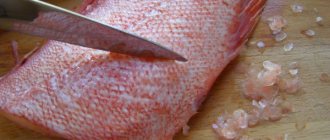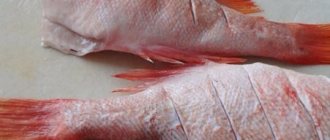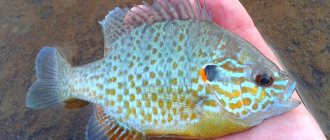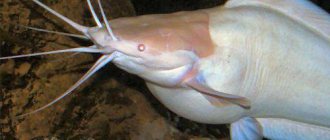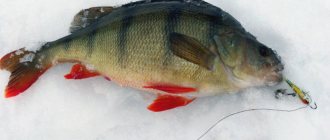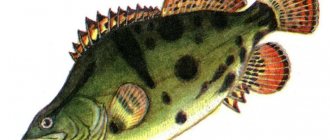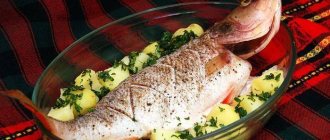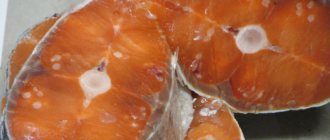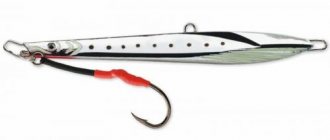Two forms of perch
Experienced fishermen and ichthyologists know that in large reservoirs with a rich food supply, perch forms two varieties that differ in habitat, diet and growth rate. The first variety is usually called "small", "grass" or "coastal" perch, the second - "large" or "deep" perch.
The small form of perch lives in the coastal zone of the reservoir, feeds mainly on invertebrates and grows very slowly, reaching a weight of no more than 30 grams by the third year of life, and the maximum weight of such a perch is no more than 70 grams. However, despite its small size, such a perch is sexually mature and capable of reproduction.
Deep perch lives in deeper parts of the reservoir, grows much faster than small perch and feeds on small fish, leading a predatory lifestyle. Deep perch has a darker color, by the third year of life it reaches a weight of 80-100 grams, and in subsequent years it gains weight by 50-80 grams annually.
Fatty fish
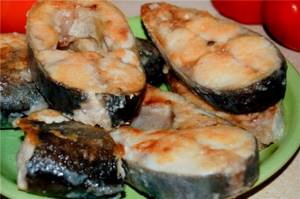
There are varieties of fish that are unsuitable for dietary nutrition. These include fish such as:
- Mackerel and catfish.
- Sprat and stellate sturgeon.
- Fatty herring and eel.
- Sturgeon and halibut.
- Saira.
These fish breeds have a fairly high fat content (more than 8.5 percent), and their energy value ranges from 270 to 350 kcal per 100 grams of product.
Despite such a high percentage of fat, these fish breeds are considered the most beneficial for humans, since their meat contains more iodine and fatty acids. The presence of such components allows a person to fight a number of ailments associated with the cardiovascular system, as well as metabolic processes in the body.
Unfortunately, they are not suitable for preparing dietary meals.
Calorie content of river and sea bass
Marine and freshwater fish have different caloric content and nutritional value. Dietary river perch has an average calorie content of 82-91 kcal. Sea bass has slightly more calories - 103 kcal.
As for the nutritional value, in freshwater inhabitants the carbohydrates in fish meat are zero, fats are 0.9 g, but river fish contains the most proteins - 18.2 g.
Marine representatives also do not have carbohydrates in their meat, but they do have proteins, the total amount of which is 18.2 g, and fats - 3.3 g.
To more accurately see how many calories are in river and sea perch, we offer a detailed calorie table, in which we have detailed each useful element of the fish product by microgram.
| Useful material | Per 100 g. product | |
| River perch | Sea bass | |
| Vitamins | ||
| Retinol (vitamin A) | 9 mcg | 12 mcg |
| Thiamine (vitamin B1) | 0.07 mcg | 0.04 mg |
| Riboflavin (vitamin B2) | 0.1 mg | 0.05 mg |
| Niacin (vitamin B3) | 1.52 mg | 4.14 mg |
| Pantothenic acid (vitamin B5) | 0.75 mg | 0.27 mg |
| Pyridoxine (vitamin B6) | 0.12 mg | 0.07 mg |
| Folic acid (vitamin B9) | 5 mcg | 9 mcg |
| Cyanocobalamin (vitamin B12) | 1.9 mcg | 1.5 mcg |
| Alpha tocopherol (vitamin E) | 0.2 mg | 0.76 mg |
| Phylloquinone (vitamin K) | 0.1 mcg | 0.1 mcg |
| Choline (vitamin B4) | 65 mg | 65 mg |
| Calciferol (vitamin D) | 3 mcg | 1.2 mcg |
| Microelements | ||
| Manganese | 700 mcg | 0.01 mg |
| Selenium | 12.6 mcg | 28.6 mcg |
| Iron | 0.9 mg | 0.22 mg |
| Zinc | 1.11 mg | 0.29 mg |
| Copper | 150 mcg | 0.02 µg |
| Macronutrients | ||
| Sodium | 62 mg | 287 mg |
| Potassium | 269 mg | 187 mg |
| Phosphorus | 200 mg | 248 mg |
| Calcium | 80 mg | 28 mg |
| Magnesium | 30 mg | 23 mg |
The table above shows the calories contained in a fresh fish carcass. But from a fresh catch you can always prepare fish dishes of a wide variety of culinary types: fried, boiled, stewed, etc.
Each separately prepared type of perch dish contains its own number of calories, which we propose to consider in the following table.
| Type of cooked perch | Number of calories |
| Sea stew | 180 kcal |
| Boiled sea | 112 kcal |
| Seafood in cheese sauce | 105 kcal |
| Fried river | 180 kcal |
| Hot smoked sea | 175 kcal |
| Salted-dried Shturval perch | 249 kcal |
| Fire perch helm | 249 kcal |
| Seafood in a steamer | 76 kcal |
Varieties of perches
In the countries of the former Soviet Union, perch fishing is well developed. In Russia, Ukraine, Belarus, and Kazakhstan, there are mainly four representatives of the perch family:
- River - greenish-yellow, up to 3.5 kg.
- Yellow - with a yellow back, up to 3-3.2 kg.
- Balkhash - without longitudinal stripes, up to 4.5 kg.
- Marine - with poisonous glands in razor-sharp fins.
At the same time, on the territory of Eurasia there are at least a hundred varieties of perch, but only those listed are caught on an industrial scale.
Characteristics of sea bass
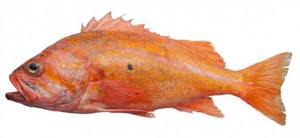
Description
Sea bass belongs to the scorpion fish family. Several species of sea bass are known in nature: from the Pacific beaked perch to the Atlantic golden perch. Some of the species are already in the Red Book, as there is a threat of their extinction. Mostly fishermen come across specimens that have a pink tint.
Sea bass can grow from 15 cm to 1 meter in length, weighing from 1 to 15 kilograms. In its shape and appearance it is similar to river perch. This fish has very sharp fins, the pricks from which take a long time to heal. Sometimes complications with inflammation of the resulting wounds are also possible. Therefore, sea bass should be handled very, very carefully.
On top of that, sea bass is considered a long-liver, as it can live from 12 to 15 years. This fish is also interesting because it does not lay eggs, as many fish do, but immediately live fry, the number of which can reach several hundred thousand, and sometimes more than a million.
Where do sea bass live?

Sea bass prefers to be at depths of no less than 100 meters and no more than 500 meters, although it has also been found at a depth of 900 meters. Its main habitat is the northern latitudes of the Pacific and Atlantic oceans.
It is caught on an industrial scale throughout the year. Since sea bass stays closer to the bottom, it is caught by bottom trawls, which in turn destroy coral reefs, which causes significant harm to the ecosystem of the oceans and seas.
Sea bass was caught especially actively at the end of the last century, which led to a sharp decline in its population. Nowadays, sea bass fishing is significantly limited. It will take more than one year for the perch to restore its numbers, as many experts say.
What are the benefits of sea bass?
The benefits of sea red snapper are multifaceted. Thanks to unsaturated fats, the beneficial properties of perch are manifested in regulating metabolism and normalizing cholesterol levels in the blood. This is an excellent prevention of the cardiovascular and nervous system.
Thanks to the relatively high concentration of vitamin B12 (the amount of which in 120 g of product corresponds to the daily norm), the cell division mechanism functions normally in the body, since this vitamin is responsible for DNA synthesis.
The vitamin and mineral complex contained in fish will be useful for people with heart and circulatory diseases, as well as people with metabolic disorders. Fish is recommended for nutrition for hypertensive patients, diabetics, and people suffering from atherosclerosis.
Sea bass: benefits
Freshwater perch can hardly be called a dietary product; it contains fats, and in each specific fish their amount differs significantly. On average, 100 gr. fillet contains 1 gr. Omega-3 fatty acids.
Fish fat
The level of fat in fish can be much higher. This natural quality cannot be called a disadvantage; rather, on the contrary, it is sea bass fish oil that can perform several important functions in the body at once:
- reduce cholesterol levels;
- regulate metabolism;
- contribute to the prevention and treatment of nervous and cardiovascular diseases.
But the beneficial properties of fatty acids are not all the unique properties of sea meat. In addition to them, perch contains many important micro- and macroelements, as well as vitamins and minerals necessary for human health.
Vitamin B12
One of these is the multifunctional vitamin B12, which helps enrich the body’s cells with oxygen at different stages of hypoxia (oxygen starvation) of tissues and organs.
B12 also takes an active part in fat metabolism and DNA synthesis.
- The universal set of beneficial properties of sea bass also includes the ability to normalize blood sugar levels.
- Perch meat also has a beneficial effect on the condition of the skin, the functioning of the thyroid gland and the digestive system.
- Thanks to protein and taurine (an amino acid involved in the construction of tissues and cells of the body), contained in fish meat, eating perch allows you to saturate the brain with oxygen, and accordingly, intensify mental activity.
- The composition of sea bass meat also includes vitamins of groups A, B, D, PP, C, E and macro/microelements (iron, copper, iodine, phosphorus, calcium, zinc, etc.), which have a beneficial powerful effect on the functioning of many organs and systems of the human body.
Where does perch live?
If we consider the entire distribution area, then our river perch is a cosmopolitan fish. It's easier to say where it is not. By the way, it is not available in Spain and Scotland. They tried to populate it, but it didn’t take root.
Europe, Asia, Australia, New Zealand, South Africa. Perch can tolerate fairly wide temperature changes. In addition, it is able to live not only in fresh water bodies. For example, it lives quite normally and for a long time in the brackish lakes of Kyrgyzstan. In running and standing water. It does not survive only in the “puddles” typical of crucian carp. Lack of oxygen in the water is fatal to perch. It also avoids mountain rivers.
There are lakes where the fish population consists either of only perch, or the predator is adjacent to one or two other species. For example, there are perch-sorog lakes.
To summarize, we can say that the adaptation of a perch is limited by several parameters:
- Water temperature. The range of existence is between 4 and 30 degrees.
- Current speed. Perch are uncomfortable in fast-flowing rivers.
- The fish can withstand some salinity, but it is not a marine species.
- Oxygen regime of the reservoir.
Bony or not?
Before purchasing and cooking, many potential consumers are concerned with the question of whether such fish is bony, because even the most exquisite recipe can be ruined by the fact that the main dish, it turns out, will then have to be disassembled by guests into the smallest details. The answer to this question is not entirely clear-cut.
As for the ordinary river perch, which you would rather not buy in a store, but catch in the fresh waters of our country, it should be considered bony rather than not.
You can find many authoritative opinions that this fish can only be considered relatively bony compared to many others.
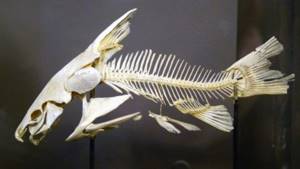
But most often only avid fishermen know about this, who are not at all accustomed to eating any purchased fish, preferring those caught with their own hands. From the point of view of a person who eats fish exclusively in cafes and restaurants, river varieties will seem like a waste of money due to the supposed impossibility of eating them due to the huge number of bones.
The situation with sea bass is somewhat different: it is not for nothing that it is considered a gourmet fish and is often served in catering establishments. However, it cannot be called a completely boneless fish, however, in this case the situation is not as bad as with its river brother.
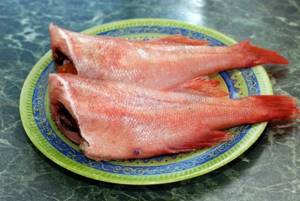
How to choose sea bass?
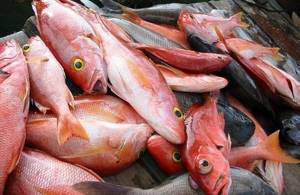
Nowadays, you can’t really rely on sellers to be honest. Everyone strives to earn as much money as possible, so they are ready to sell even a product that is not fresh. To avoid buying substandard goods in a store or market, you should follow these simple rules:
- You should opt for carcasses that are bright red or pink, with white skin visible under the scales.
- The frozen carcass should have a neat appearance, without signs of re-freezing.
- If the fish is fresh, it should have an elastic surface and light eyes. In addition, the gills should also have a fresh pinkish tint, but not gray.
- Sometimes you can see sellers trying to pass off fillets from cheaper fish, such as hake, as fillets from expensive sea bass. But the meat of these fish is easy to distinguish visually: sea bass has pure white meat, while hake has yellowish meat.
- When buying smoked sea bass, it is better to give preference to a factory-made product, but not to a product prepared in a private enterprise. These delicacies can also smoke stale carcasses: the main thing for them is the huge earnings from the sale of their product.
Natural enemies
Natural enemies of river perch are fairly large aquatic inhabitants, represented by pike, catfish, pike perch, salmon, burbot and eel.
Perch is often hunted by loons, osprey, gulls and terns. Perch is one of the very popular objects of domestic and foreign recreational fishing, so the main enemy of such an aquatic predator is still humans.
Cannibalism is characteristic of perches, which is especially common in the autumn, but in some natural reservoirs inhabited only by such a river predator, the process of cannibalism is the norm of life.
Methods of catching perch
As soon as the reservoir is covered with ice, the perch bite is the most active. It occurs when the ice is still ultra-thin. Since schools of striped fish have not yet established themselves in certain places, perch are biting throughout the entire area of the reservoir. First of all, the entire plane is examined, because the fish can stop anywhere.
There are several ways to catch perch in winter, such as: drilling with a zigzag, the same envelope, placing live bait fishing rods, under-ice echo sounder, group research. Each of the methods is a very important assistant in finding perch both at depth and in small bodies of water.
The fishing gear for perch can be a marmy with a bait, a reelless bait, a perch bait, a live bait fishing rod, or a spinner. With jig gear for perch, everything is clear, the first one is attached with a bloodworm, the second one works without attachments, provoking and luring the perch. Lure tackle - balancers, spoons, amphipods, silicone baits, flies, cicadas.
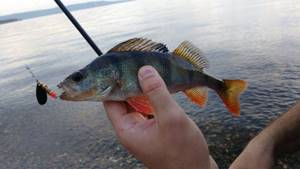
In the summer habitats of the fish, fishermen successfully catch it with spinning rods and large lures for perch. The spoon is cast in the bottom layer, close to stones, koryak, and so on. Subsequent casts are made closer to the school of caught fish and their movements are monitored.
On weak currents or reservoirs where the water is in a calm state, summer fishing for perch using a winter lure in a plumb line from a motor boat. In summer you can fish with a jig and a long fishing rod.
The bottom topography is of great importance. Usually the fish is in the bottom layer of the reservoir, so using a depth gauge, you can track the depth of the nozzle, which is held depending on the immersion of 20 centimeters from the bottom. Sometimes perch is found in the upper layers of a reservoir, for example, it is caught while hunting for fry.
Perch fishing gear
In the warm season, until the reservoirs are covered with ice, perch is fished with summer gear: a float rod and a spinning rod. The perch bites for sure, the float flies away sharply under the underwater without any preludes, and the sensitive spinning rod transmits a blow or jerk well to the hand. Not every predatory fish can compete with it in the manner of such a bite.
Float rod and bait for it.
For fishing for perch from the shore, a regular Bolognese rod is suitable - a telescopic rod 5 m long with a spinning reel. To catch perch from a boat, any 1.5 m - 2 m folding rod with guides and a reel seat is enough. In boats, you can easily get by with a small open-type inertial coil with a diameter of 70 mm. The equipment for live bait and conventional bait differs in the size and weight of the float, since the live bait on the hook constantly resists, the float must have good buoyancy and a carrying capacity of at least 20g -30g so that the fry does not drown it.
Usually fishermen make them themselves from thick foam plastic, using a stationery knife and sandpaper; you can buy ready-made floats for fishing with live bait. The humpback fish is caught with a worm - a crawler, live bait and a small frog, you can try it with a leech. Fish that do not fall asleep on the hook for a long time are used as live bait.
For common baits: worms, caddis flies, maggots, motels, dragonfly larvae, etc., which are used to catch small and medium-sized perch, a spindle-shaped float with a carrying capacity of 5 - 8 g, corresponding to the fishing conditions, is suitable. A light float is not advisable, since the perch immediately grabs the bait and immediately drowns the alarm; of course, it will not be able to drag away a 200-300 g buoy.
Catching perch with a spinning rod
In the warm season, fishing with RO* with a spinning rod is considered a productive and also very exciting activity. The characteristics of the rod will largely depend on the size of bait you are going to use to carry bass. Medium - Light spinning rod with a test weight of 5-18 g or Light spinning rod with a test weight of 5-13 g are the most optimal rod power classes for this purpose. It is better to take a length of no more than 1.7 m - 1.9 m; such a rod is easier to handle.
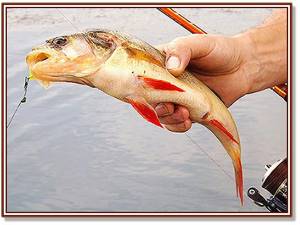
Take a spinning reel, size “2000” or “2500”. The cord is braided 0.1 mm -0.12 mm, suddenly a pike grabs a perch while fishing, this also happens, but in general the tensile strength of the cord should correspond to the test of the rod along the line.
Lures for catching perch using a spinning rod
Silicone twisters and vibrotails
To catch perch using a spinning rod, use silicone baits with jig heads or eared weights on a hinged mounting.
The range of perch twisters and vibrotails is from 1.5 cm to 15 cm. They are used with weights or jig heads corresponding to their weight. Small sailors are caught using miniature baits weighing from 1.5 - 4 g, but it happens that they also catch perch of considerable size. The largest baits are good for trophy predators; intermediate sizes from 5 cm to 10 cm are considered the most popular and more catchy, as they are acceptable for fish of different sizes.
The reader will probably be interested in how to determine the appropriate weight of the head for a silicone bait. The weight of an eared sinker or jig head is selected according to the following criterion: the bait must imitate a live fish in its behavior and appearance. If you consider that during a pause, the silicone blende sinks to the bottom upside down, which is the lead head of the hook or a spherical sinker, then it will immediately become clear that the weight of the sinker affects the speed of its immersion.
A living object, like a bait, cannot fall to the bottom like a stone, and it is quite difficult to notice it at such a speed, and at the same time, a slow dive will not cause active vibrations of the moving part of the twister or vibrating tail, which is also not “very good”.
Therefore, the weight of the sinker is selected in such a way that when immersed, the silicone product is noticeable and makes intense vibrations with the tail part, i.e. It went down neither very quickly nor too slowly.
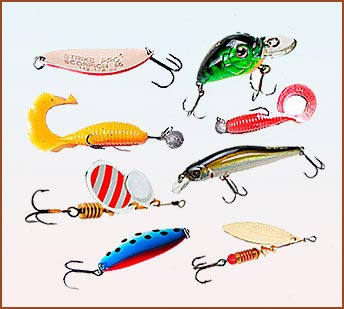
Do not forget that the casting distance depends on the weight of the bait with a sinker, this also applies to wobblers and spinners, and light equipment, the weight of which does not exceed 3 - 5 g, can only be thrown with an ultralight spinning rod, from which I would not recommend mastering spinning gear.
It’s fun to catch fish with edible rubber, which differs from ordinary silicone in its special softness and flavor additives. The sailor can chase the twister for a long time, biting off a piece of its tail, but deciding to grab the whole thing. It happens that he grabs the decoy right near the shore or attacks only on the second try.
Rotating lures for perch
The spinner, the favorite bait of perch, oh, and they love the high-frequency vibrations of its rotating petal; if a striped fish is nearby, it will never miss the spinner. The running size for catching stripers is considered to be numbers from No. 0 to No. 3. The shape of the pinwheel blade is selected depending on the current - link. It is worth noting that spinners are very catchy baits and cling not only to fish, but also to surrounding objects: grass, snags, stones, etc. and are easily lost. It is advisable to fish with them in clean reservoirs with sparse vegetation.
Oscillating spoons are an effective tool for perch.
Oscillating spoons are a classic for catching ichthyophages. They appeared as the very first of the artificial baits. They are used to catch any predatory fish, including RO*. Choose the size of the spoon no more than 3 – 5 cm, but the shape depends on the fishing conditions: current speed, depth and fishing technique.
Perch wobblers.
Many spinning anglers prefer to catch perch with wobblers, and not all are suitable for them, but special shapes: cranks, shads, fades - providing the bait with active play with any and even uniform retrieve. Minnow wobblers have proven themselves well in RO. True, they have a weakly expressed game, but in experienced hands they quickly become natural thanks to twitching - jerking.
Sizes from 4 cm to 10 cm are considered popular, although at 4 cm wobblers fly poorly and play weakly. From my personal experience I will say: “Take larger baits, they are heavier, so it’s easier to throw them far and they play better, and these are the main criteria for catching perch. And if the perch is hungry, it grabs a wobbler slightly smaller than its height.
How to cook perch
When preparing dishes from fish such as perch, it is necessary to distinguish whether a sea or river predator has fallen into your hands. Many housewives, still unfamiliar with representatives of the perch family, are concerned with the question: is the perch bony or not?
If we are talking about a sea creature, then we can say with confidence that yes, but a river creature is its complete opposite; there are very few bones in its meat. This nuance is very important when preparing dishes, especially if your family does not like bony fish.
River perch
Cooks all over the world exploit this freshwater predator in different ways: dried, fried, smoked, baked in foil, salted, etc. In many European countries, pies and soups are prepared from perch fillets, and pieces of fish are also added to risotto. It is considered a good tradition to serve perch with a noble drink; in Italy this is considered white wine.
If you don’t have the money to prepare expensive delicacies, you can do it much simpler - make aspic, rich fish soup, steamed or stewed cutlets from freshwater perch. A great idea would be to hot smoke the fish over beech, maple or oak logs.
After cooking, river fish becomes very juicy, the meat acquires a sweetish taste and specific tenderness.
Sea bass
Cooking sea bass is in many ways similar to river bass. However, fish from the sea have a slightly different taste.
It is this taste feature that cooks from all over the world use to prepare special dishes.
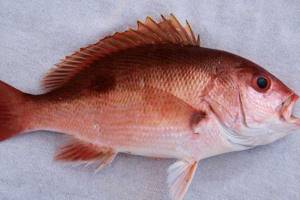
- Of all the types of preparation of sea bass, salting is considered the most successful way to process fish carcass.
- Sea bass is most often used in Japanese cuisine, for example, the fish is used to make sashimi, sushi, etc.
- You can also make canned food from perch. If you prepare them at home, you can fully rely on the natural quality of the fish product - it will retain its taste and freshness for 3-4 months, given that the temperature in the refrigerator does not fall below 18 °C.
In general, no matter what kind of perch you choose for your dish, it is in any case a good decision. You already know why perch is useful, and after tasting it, you will also understand why fish is so loved in many cuisines around the world.
Don’t be afraid to conduct culinary experiments with fish; perch is always ready for any type of heat treatment. If you have never tried a dish made from this fish, then quickly change your traditions. We are waiting for you to join the ranks of those who have already included perch in the “best of the best” honorary list.
Population and species status
In most countries, the common or river perch is not a protected species, and today it is subject to some restrictions that are generally imposed on the catch of any freshwater fish. Catch limits can vary significantly even within the same country. For example, in Wales and England there are now several seasonal bans on perch fishing, and in some countries perch that have not reached the legal limit must be released alive back into the reservoir. At the same time, the density of river perch accumulation can vary significantly in different reservoirs.
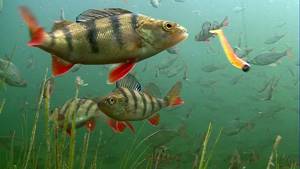
Return to content
What does perch eat?

The diet of perch is determined by the availability of prey, its size, and number. There is no denying that perch is a predatory fish. However, in most cases he has to eat various small things. Even after reaching adulthood.
In the first year of life, perch fry consume plankton. The juveniles start feeding on benthos in the second year of life. By this time, their gastrointestinal tract is already ready to consume benthic invertebrates. These include larvae of mosquitoes, caddisflies, and other insects.
Growing to a size of 13-15 cm, juvenile perch begins to engage in predation. During this period, perch cannibalism begins to develop. It is at this stage that the division into “grass” and “sea” (deep) begins. The first migration to the depths and to the shore puts its end. Perch remaining in wintering areas becomes a real predator earlier. Those that have returned to their summer camps begin to eat benthos and fish larvae.
However, here you need to take into account that the reservoirs are different. Just like their population. Lakes inhabited exclusively by perch will definitely be inhabited by cannibals. The attraction (need) to hunt for relatives in this case is revealed already in the first year of life.
As for large perches, they will not disdain to eat dragonfly larvae. However, they are not destined to feed their growing body on boogers. Humpback whales need normal, complete food. Fish, crayfish, frogs. Moreover, the percentage of one or another type of food can be quite impressive. For example, studies of Volga perches in the mid-80s revealed that the diet of perch includes 20% crayfish.
Thus, perch is a predatory fish. The diet is very varied. It is determined by the size of the fish, the availability of food, and areas of residence in the reservoir. Naturally, this must be taken into account when going fishing.
If a fish bone gets stuck in your throat

A fish bone is stuck in my throat, what should I do? How to remove it at home? Anyone who has eaten bony fish at least occasionally knows the unpleasant sensations when a small fish bone gets stuck in the throat or tonsils. It becomes difficult to swallow, any swallowing movements cause pain. What to do if a bone is stuck in your throat? The main thing is not to panic.
In most cases, it is possible to get rid of a fish bone without outside help, on your own, if it is a small and soft bone. There are several simple and relatively safe ways to get rid of such a bone in the throat.
We warn you: doctors do not welcome “amateur activities” and advise you to immediately consult a doctor. The fact is that the results of manipulations with a fish bone may turn out to be impossible to get rid of it and you will still need to go to the doctor. At the same time, the bone may become even more stuck in the throat, and even for a specialist it will be more difficult to remove it.
So, there are two options - we do everything at home, at our own risk, on our own, or we go for professional help. All methods of getting rid of a fish bone at home are based on mechanical action on the fish bone by swallowing something that can drag the bone into the esophagus, or rinsing.
- Bread pulp. The bread is partially chewed until moist and swallowed with a pronounced gulp. The bread can be soaked in fresh honey. This is perhaps the most effective way.
- Enveloping products. Instead of bread, you can use thick drinks (yogurt, fermented baked milk, kefir), fresh flowing honey, or eat, for example, a banana. If the bone is caught slightly, this may help.
- Vegetable oil. If you take a small sip of vegetable oil, there is a chance that the bone, under the influence of the lubricant, will slip out and move towards its destination.
If, as a result of the actions taken, the bone from the fish does not go into the digestive tract, you should consult a doctor. This cannot be delayed, otherwise the inflammatory process will begin and the pain will intensify.
That's all. Let's end on a beautiful note: salmon, going to spawn, crosses the road.
Source: Winter-Fishing.ru
Is sea bass bony or not?
The most dangerous and predatory fish on Earth is the white shark
A predatory fish called the man-eating shark, carcharodon, or great white shark, is the most feared and one of the largest fish on our planet. On average, these predators grow up to 4.7 meters in length, but ichthyologists have recorded individual individuals reaching 7 meters in length and weighing up to 1900 kilograms. Sharks have no bones; their skeleton consists entirely of cartilage. The skin of many of them is covered with razor-sharp spines. Interestingly, the inhabitants of some islands use shark skin as a polishing material.

Boneless fish: top 10 species with names and photos
We present a rating of the least bony fish found in nature.
Shark
This large cartilaginous fish lives in many oceans in different parts of the world. Not every country eats it, so it is considered a delicacy. The main feature is that its skeleton does not consist of bones, but of fused cartilage - their mobility determines the speed of movement and the sharpness of the shark’s grip. Conventionally, it can be classified as a boneless fish, because in fact it has no bones. This animal is not difficult to carve: thanks to the large size of the cartilaginous skeleton, getting it out of the flesh is not difficult.
Beluga
The largest of the freshwater species, it can reach a length of up to 9 meters. Distributed in the Azov, Black and Caspian seas, as well as in the Danube, Dnieper and other rivers. The skeleton of this sturgeon fish consists of cartilage and one bony chord, which does not have small branches of bones into the flesh. Due to this, the beluga skeleton is quite fragile and weak, which, however, is an advantage when cutting up this species: filleting a beluga does not require much time and effort, the cartilage is removed very easily. At the same time, it is not so easy to feast on beluga: it is listed in the International Red Book as a rare species.
Stellate sturgeon
This deep-sea fish with a characteristic narrow, elongated body also belongs to the sturgeon - it has a similar skeletal structure. The absence of large bones (the skeleton also consists of cartilage and bony notochord) and tasty meat explain its high consumption ratings in the food industry. The valuable industrial stellate sturgeon lives in the Danube, Volga, Black Sea and Don.
Sterlet
Sturgeon fish, found mainly in the Black and Caspian Seas. It has no small bones - the skeleton consists of fused cartilages and a single base - the notochord (outwardly it resembles a winding cord along the entire length of the sterlet's body). Such a skeleton does not have the characteristic bony vertebrae - it is the cartilage that forms the semblance of the vertebral sections. This fish is so tasty that it is caught when it has not yet reached its maximum weight, which is why its population has recently decreased significantly.
Sturgeon
Freshwater sturgeon belongs to the ray-finned class. Distributed within the middle zone of Europe. It is noteworthy that he spends a certain part of his life in the seas - this happens during spawning. The sturgeon is a real long-liver: some individuals lived up to 100 years! Like most sturgeons, the skeleton of this fish does not have bony vertebrae: it consists of cartilaginous sections. Bone plates are still found in the body of the sturgeon, however, this does not prevent it from being classified as one of the least bony fish species.
Thorn
This sturgeon is also a popular fishery item. It lives in the Azov and Caspian Seas, but can swim into rivers to produce offspring. Its skeletal skeleton consists of 5 rows of bony scutes (plates), but the fish does not have fully developed bones. Due to its enormous popularity in the middle of the 20th century, the thorn population has decreased so much that it is now listed in the Red Book, and no more than 6 tons per year are allowed to be caught.
Macrurus
This deep-sea ray-finned specimen primarily inhabits the Pacific Ocean. It has an unconventional appearance: the tail section is very thin and long, which is why the head section appears unnaturally large. Macrurus is a very useful fish, containing a large amount of vitamins and microelements, however, due to its very sharp, dangerous scales, it is not caught on an industrial scale, but is sold already cut or filleted. The skeletal network is poorly developed and mainly consists of the long tail bone. The fillet is pale pink, soft, without small bones.
Burbot
The cod-like burbot prefers exclusively freshwater bodies of water. Distributed in the waters of Europe, Mongolia and China. Its skeleton has a bony base, but most of it is cartilaginous formations. The burbot loin has no small bones, the scales are not sharp, the meat is tasty and healthy, and the burbot is very prolific, which allows it to be caught in large volumes.
Acne
The eel has several subspecies, but basically they all belong to marine predators. A distinctive feature of the eel is its characteristic serpentine body, which does not have a full-fledged bone skeleton: it is soft, pliable, and lacks characteristic bone minerals. Although there are many vertebrae (up to 150), there are no ribs and no small bones. These fish swim, moving like snakes. The meat of this delicacy is tasty and nutritious, traditionally used in Japanese cuisine.
Mullet
Rounding out the ranking of the least bony fish is the mullet, a marine ray-finned fish (which, by the way, has about 17 subspecies). Prefers warm waters of America, Australia, South Asia. The skeleton consists of large plates through which the spinal cord passes; there are no small bones. Mullet meat is low-fat and very tasty, which is why it is used for preparing various dietary dishes.
Interesting facts about perch
Aleutian perch is one of the longest-livers on earth. The maximum recorded age is 205 years.
Black Sea perch is capable of changing sex throughout its life. At birth, the fry is only female, but after 2 years the reproductive system changes to male, and from that moment the fish becomes male.
When farming white bass, they must be sorted to prevent cannibalism.
Deep water red snapper are in short supply. Its population has recently declined and continues to decline.
When studying the nature of this fish, new and new facts are discovered. Perch is of interest to people of various professions: cooks, fishermen, divers. Tell us in the comments if you have ever tried it? Share your cooking recipes.
What kind of fish can you eat while losing weight?
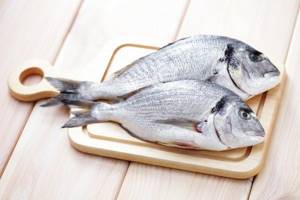
When losing weight, it is often recommended to replace fatty meat with fish products. But when choosing it, it is worth dividing it into fatty, low-fat and non-fat.
To understand the fat content, you can look at the meat. Light indicates a lean variety. The logic is simple, the darker the meat, the higher the calorie content of the product. Of course, fatty fish is rich in beneficial elements, but when losing weight you should avoid it or minimize your consumption to no more than 1 piece per week.
Low-fat lacks the carbohydrate part. These varieties are very popular in low-carbohydrate diets. Using low-fat fish in your diet will allow you not to reduce carbohydrate consumption.
We suggest you read: When to remove broccoli from the garden. Broccoli, when to harvest. Features of cultivation
How and when to introduce fish into a child’s menu?
Introducing your baby to fish should be delayed until a year. If he is prone to allergic reactions, then even at 12 months it is too early to introduce fish. And if the baby is completely healthy, tolerates other foods that you have already introduced him to, and there are no ailments on the part of the child’s body, then from the age of 10 months you can offer him to taste fish.
It should be pitted, steamed or boiled in water and crushed. For the first time, give your child half a teaspoon - like any other new dish, it is better to do this in the first half of the day, and do not give another new product that day. Then, if no reactions from the body were noted, after a week you can offer the baby half a spoon again. Gradually increase the portion of fish to 50-70 g, but do not give it more than twice a week. A child after one year can eat no more than 100 g of fish per meal, no more than twice a week (this schedule should be followed at least until 3 years). Moreover, on this day it is better not to give him meat.
Remember that caviar and canned fish have nothing to do with baby food, so they should not be included in the diet of the little ones. A variety of seafood delicacies, such as mussels or scallops, are also best postponed until later in life. And you should avoid crab sticks altogether: they are fish waste and have nothing to do with healthy nutrition.
Frying small fish without bones
Heat treatment of fish softens fish bones. Vegetable oil, unlike water, warms up significantly above 100 degrees. Under the influence of this temperature, small bones in boiling oil almost completely dissolve. It turns out to be fish without bones.
This way you can fry fish that are not very suitable for frying due to the large number of small bones - medium-sized roach, bream, silver bream, ide and similar fish. Crucian carp is traditionally fried, and transverse cuts on the sides, definitely during the frying process, rid the crucian carp of many fork bones.
See what it looks like:
Fish without bones
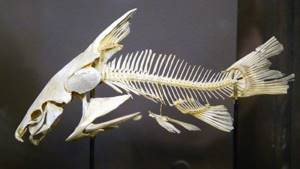
In cooking, sea and river fish are divided according to their bonyness:
- Fish without bones;
- Fish with a small number of small fork bones;
- Bony fish (bony).
In one article it is impossible to give the entire list of river and sea fish without bones, small-bone and bony fish - there are thousands of names. We will name only those types of fish that we often hear about, that we catch, cook or eat; there are no sharks or moray eels. The lists include fish that some people like and others don’t, some that are affordable and some that are expensive, some that are rare and some that are not so rare, and that vary in their degree of usefulness, safety, and taste. To avoid offending anyone, the names of the fish are in alphabetical order.
Fish without bones, or without small bones, are sturgeon, some cod and salmon. It can be river, lake, migratory or sea fish.
Migratory fish are fish that enter the fresh waters of rivers to spawn. Migratory salmon rise upstream in rivers, overcoming any obstacles in their path, spawn, and then slide downstream and die. Migratory sturgeons enter rivers, but do not rise high and return to the sea until the next spawning season. The river eel, on the contrary, goes to sea to spawn. Migratory and semi-anadromous fish can live in both fresh and salt water.
River fish and migratory fish
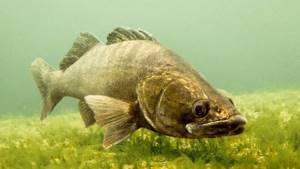
Sturgeon. List of these fish with photos
Sturgeon, sturgeon, is the general name for freshwater sturgeon, anadromous and semi-anadromous fish. This is an osteochondral fish species that can live 50, 100 or more years. Black caviar is a product of sturgeon fish.
- Beluga (the largest freshwater fish of the sturgeon family, listed in the Red Book)
- Kaluga (sturgeon freshwater fish of the beluga genus)
- Russian sturgeon
- Sevruga (sturgeon family, migratory fish)
- Sterlet (freshwater fish of the sturgeon family, grown in ponds and lakes)
- Thorn (sturgeon anadromous fish)
Other river fish without bones - list with photos
- Burbot (freshwater representative of cod)
- River lamprey (jawless predatory fish)
- River eel (migratory fish, spawns in sea water)
River fish with a few small bones:
- Carp (wild carp)
- Catfish (large freshwater predator)
- Pike perch (perch family)
Salmonidae
Salmon, salmon, is the general name for fish of the salmon family, including freshwater inhabitants and migratory ones. Red caviar is a delicacy, the roe of salmon fish.
- Pink salmon (genus of Pacific salmon)
- Chum salmon (salmon fish)
- Salmon (Atlantic salmon, lake salmon)
- Whitefish (salmon, there are many varieties of whitefish)
- Taimen (freshwater fish, the largest representative of salmon, listed in the Red Book)
- Trout (several species of fish of the salmon family that live in fresh water)
Sea fish
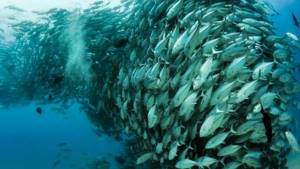
In parentheses are notes and key features. List of boneless (or almost boneless) sea fish:
- Vomer (selena, moonfish)
- Yellowtail, or lakedra (mackerel fish)
- Catfish (sea wolf, perciformes)
- Flounder (flat bottom fish)
- Mullet (there are freshwater representatives)
- Icefish (white pike)
- Mackerel (mackerel fish)
- Macrurus (rattail, deep-sea cod-like fish)
- Pollock (cod fish)
- Sea bream (perciform fish)
- Sea bass (Scarpenidae family)
- Conger eel (passively poisonous fish)
- Sole sole (European sole, flounder fish)
- Navaga (Far Eastern navaga, cod family)
- Halibut (flounder)
- Haddock (cod family)
- Seabass (from sea bass, laurel, koykan, sea wolf, sea pike perch, etc.)
- Mackerel (mackerel family, order Perciformes)
- Horse mackerel (different types of fish from the horse mackerel family)
- Tuna (tunas are a group of fish of the mackerel family)
- Hake (hake, cod-like fish)

